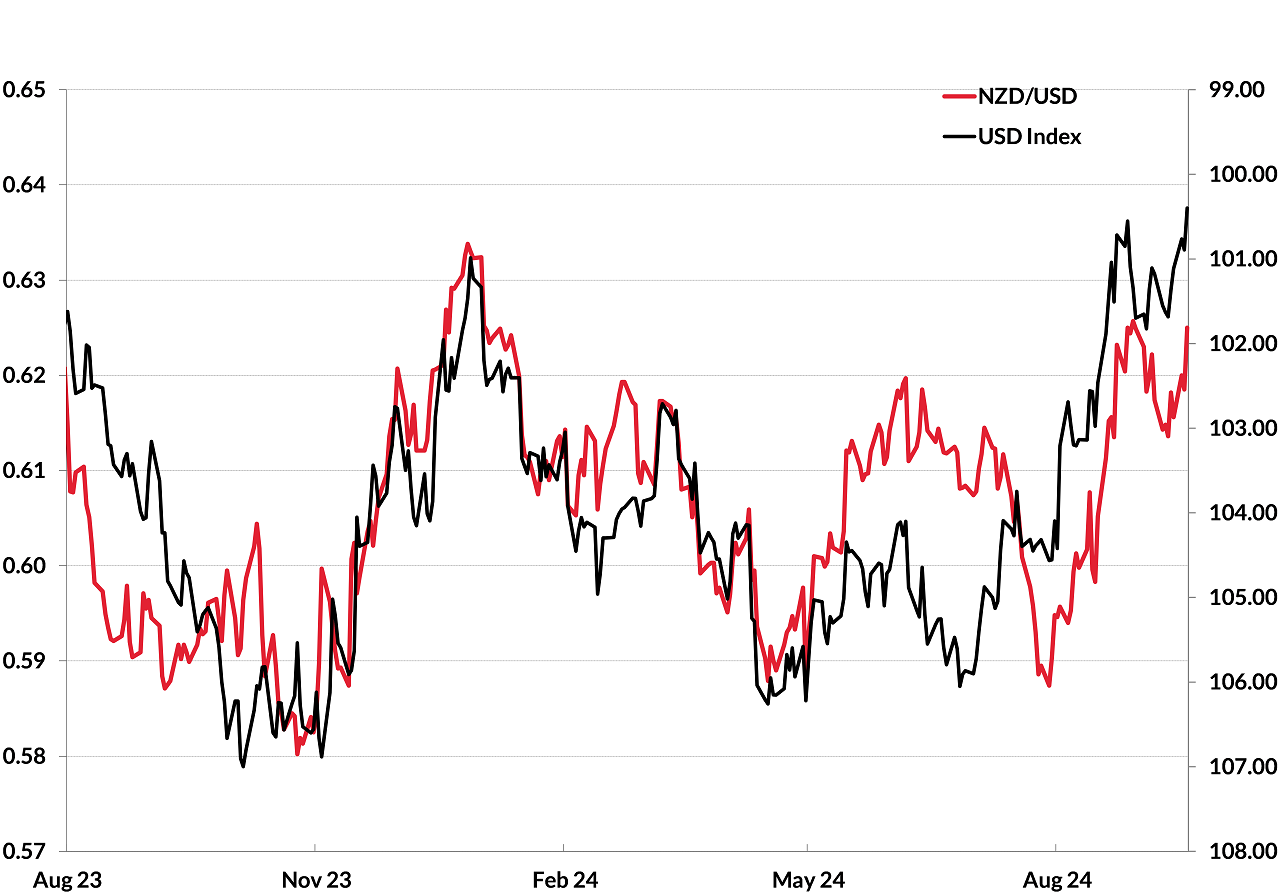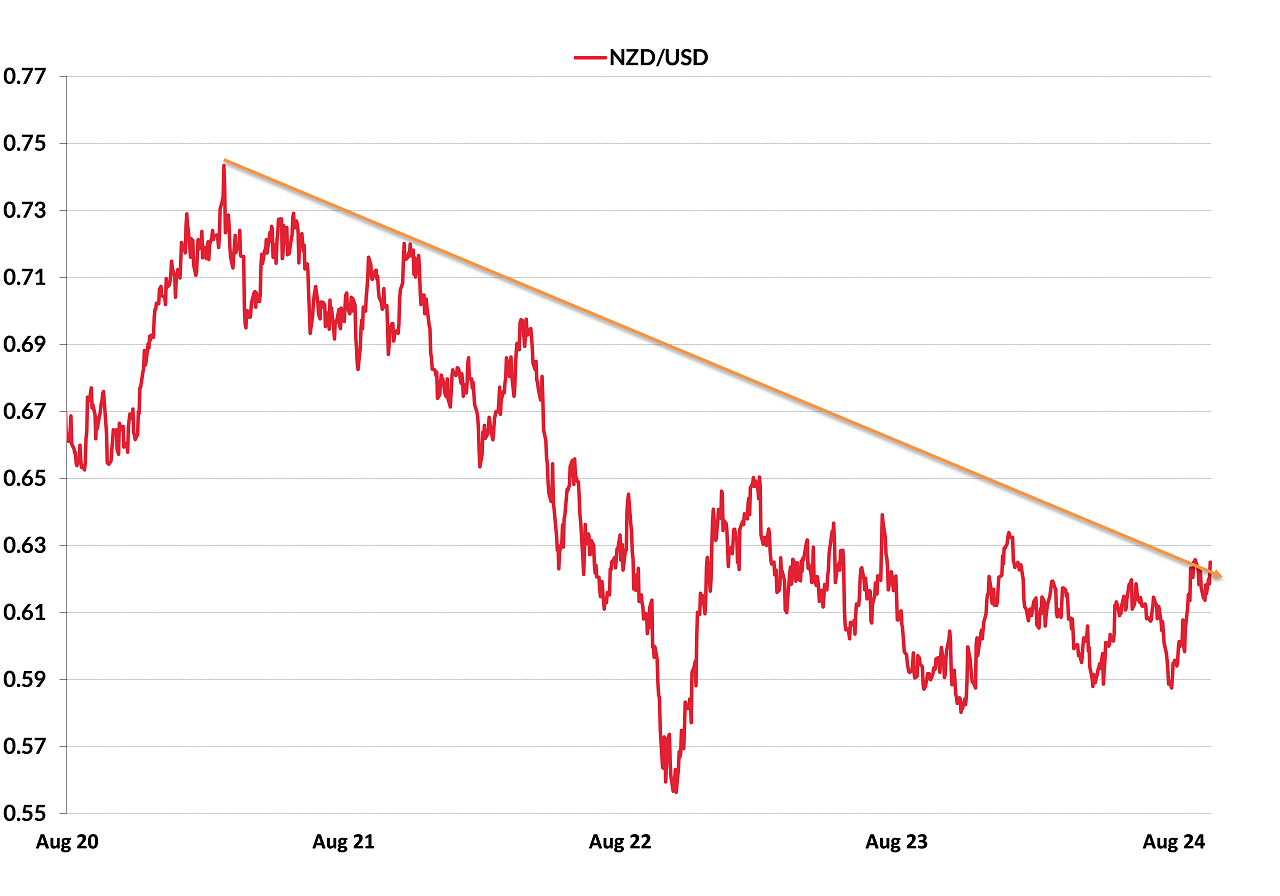
Summary of key points: -
- What lower US interest rates mean for the global economy
- The Bank of Japan is proving to be hard to read
- Kiwi dollar approaching a key chart level
What lower US interest rates mean for the global economy
In last week’s commentary we proffered the view that the US Dollar Dixy Index would depreciate to below 100.00 if the Federal Reserve (“Fed”) cut their Fed Funds interest rate by a bold 0.50%.
Our opinion was that the Fed should frontload the monetary easing cycle with a 0.50% cut as the US employment market had abruptly softened over recent months and this change justified restrictive monetary conditions being removed. In a volatile period of trading in financial and investment markets following the Fed statement and media conference last Thursday morning, the USD Index did briefly trade below 100.00. However, in some very wild and uncertain trading post the Fed statement, the USD reversed upwards to above 101.00 at one point, and finally settled on Friday at 100.40.
Through these short-term USD gyrations, the NZD/USD exchange rate climbed to a high of 0.6270 and settled at 0.6245. Local importers with FX orders placed in the market above 0.6200 had the orders triggered to add to short-term hedging over the US Presidential Election risk period of the next seven weeks.
The Fed were able to reach the decision to cut by 0.50% as US core inflation over the last three months has been running at a calculated annualised rate below their target of 2.00%. If the outdated and disruptive housing/shelter CPI data was recorded accurately at current market rental increases of 2.00%, the annualised core inflation rate would be closer to 1.00%.
Whilst a 50-point cut was largely priced-in by the US bond market beforehand, there remains a stack of investors, borrowers, fund managers, companies, sovereign wealth funds and central banks around the globe who will be surprised at the distinctly rapid turnaround in the Fed’s stance. They have moved from virtually no cuts this year in their June statement, to indicating 4 x 0.25% = 1.00% of cuts before year-end in their September statement. There is no question that most of the members on the Fed’s FOMC completely miss-read the strength of the labour market in the US economy throughout 2024 and are now having the make hasty adjustments to their overly hawkish outlooks earlier in the year.
Sharply falling US interest rates has many implications for the US and world economies: -
- Emerging market economies with debt in US dollar’s get an instant interest cost relief which is good news all round.
- Asian economies defending their respective currency values against a strong US dollar when US interest rates were increased can now relax somewhat.
- Commodities traded and financed in US dollars get a boost as holding costs reduce.
- Business investment returns above the cost of capital thresholds are more easily achieved, therefore encouraging expansion/growth in the US and world economy.
The only players who are disadvantaged by falling US interest rates (and the associated depreciation of the US dollar) are investors who bought USD’s some time ago, enjoyed the high interest yields and currency gains, however they are now seeing their investment strategy turn horribly negative. These are the parties who we believe will generate the second wave of US dollar selling to 95.00 on the Dixy Index as they exit their USD holdings.
The sheer dominance of US dollar movements (and AUD movements) over the NZD/USD daily direction was yet again convincingly demonstrated last week with the Kiwi dollar appreciating, despite the New Zealand economy again contracting in the June quarter. Local economic news and development does not have the influence over the New Zealand exchange rate that it once may have.
The chart below confirms the very close correlation between the USD Dixy Index and the NZD/USD exchange rate movements. The Kiwi dollar is lagging the USD Index somewhat currently as it traded above 0.6300 when the USD Index was last below 101.00 in December 2023. Australian dollar and Japanese Yen movements are the next major influences on Kiwi dollar movements, and it does appear that the Yen weakening back to 144.00 from 140.00 over recent days has restricted the NZD from making further ground higher against and overall weaker US dollar.

The Bank of Japan is proving to be hard to read
After roundly praising the Japanese authorities last week for executing a successful currency market intervention strategy to turn the direction of the Japanese Yen around, the Bank of Japan confused everyone this week with comments on the timing of their interest rates increases.
Governor Kazuo Ueda indicated the Bank of Japan is not in a hurry to increase interest rates again after hikes in March and July. The Yen immediately weakened back to 144.00 from 140.00, reflecting general confusion in the FX markets to the unexpected caution from the Bank of Japan. Mr Ueda stated that the “Bank of Japan could afford to spend time eyeing the fallout from global economic uncertainties”. He must have been referring to the out-sized reaction by global financial and investment markets to the unwinding of Yen carry-trades that caused massive volatility in early August. However, that was seven weeks ago, and the markets quickly settled and moved on. Governor Ueda also stated that is monetary policy decisions “will be based on economic, price and financial developments”. It was not expected that the Japanese would increase their interest rates at last Friday’s meeting, however a clearer guidance as to when the next increase will be was anticipated by the markets. They did not get that.
The Bank of Japan is still forecasting higher inflation (justifying rate hikes), but they said that there was now raised uncertainty over the economic outlook in the US. Maybe they were not expecting the Fed to cut interest rates by 0.50%.
The comments from Mr Ueda were not inconsistent with their gradual approach to increasing interest rates and they have stated previously that the central bank is not on a “preset” course. The majority view is that the Japanese will still increase their interest rates by another 0.25% before Christmas.
It does not look like the FX markets will sell the Yen a great deal further as many Japanese investment houses could be expected to take the opportunity of a 144.00 USD/JPY exchange rate to returns funds to home base. The closing yield gap between US and Japanese 10-year Government Bonds continues to point to further Yen gains to 130.00.
Kiwi dollar approaching a key chart level
A feature of the NZD/USD exchange rate trading patterns over recent years is that every recovery upwards by the NZ dollar is to a level that is lower than the previous rebound higher. Since 2021, the Kiwi dollar has failed in every attempt (for whatever reason) to appreciate above the previous spike upwards. Over the last two years the NZD/USD has traded within a narrow 0.5800 to 0.6500 range. Over this period, the Kiwi has climbed back up to 0.6300 on several occasions, only to reverse back down again.
The repeating pattern could be about to change, with now much more certainty about rapidly decreasing US interest rates and therefore a lower US dollar value. Over coming months, the Kiwi dollar has the best chance in a number of years to break out of the previous cycle and make more sustainable gains against the USD. A clear break higher to above 0.6350 would have the Kiwi dollar above the previous peaks and perhaps attracting some fresh hedge fund speculative buying (based on the technical/charts) as a major turning-point is confirmed.
A move lower to below 0.6100 over coming weeks/months would negate the potential positive chart position and confirm that the existing medium-term downtrend in the NZ dollar is still in train.
Whilst New Zealand’s economic well-being and performance may be poor at the moment, that does not automatically translate into a depreciating NZ dollar value. For the NZD/USD not to maintain its close correlation to the USD Dixy Index, an unexpected event or development would have to emerge to send the Kiwi dollar on its own path. Many commentators cite a New Zealand Government credit rating downgrade as a factor that would send the NZD lower on its own account. However, unless our export commodity prices plummet from current good levels (logs excepted) a credit rating downgrade seems extremely unlikely.
What is far more important for the future NZ dollar direction is whether the US dollar continues to depreciate and how much the Australian dollar and Japanese Yen (which the NZD follows) benefit from that.

Daily exchange rates
Select chart tabs
*Roger J Kerr is Executive Chairman of Barrington Treasury Services NZ Limited. He has written commentaries on the NZ dollar since 1981.

We welcome your comments below. If you are not already registered, please register to comment
Remember we welcome robust, respectful and insightful debate. We don't welcome abusive or defamatory comments and will de-register those repeatedly making such comments. Our current comment policy is here.